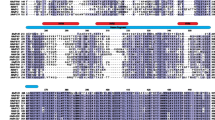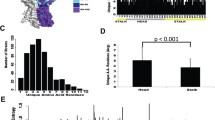Abstract
Adenovirus (Ad) capsids that display exogenous epitopes can be potently immunogenic, eliciting a potent humoral response against components of the capsid. We used the epitopes flag, his6flag, his6lgsflag and AdV4HVR5 as model antigens to characterize the hexon hypervariable region (HVR) 1 as a site for epitope insertion. A peptide of up to 17 amino acids could be incorporated into HVR1 of the Ad3 hexon without adversely affecting the biological characteristics of the virus. Multiple vaccinations with capsid-modified Ad3 induced a humoral response against the epitope inserted in HVR1. However, antiserum against the his6flag or his6lgsflag epitope did not recognize glutathione S-transferase (GST)-his6 and GST-flag fusion protein. Our study illustrates that there is an immune response against the new epitope within the amino acids of his6flag or his6lgsflag epitopes. This discovery could be a warning for the generation of multivalent vaccine vectors by incorporation of multiple epitopes into single HVRs.






Similar content being viewed by others
References
Yang Y, Jooss KU, Su Q, Ertl HC, Wilson JM (1996) Immune responses to viral antigens versus transgene product in the elimination of recombinant adenovirus-infected hepatocytes in vivo. Gene Ther 3:137–144
Schagen FH, Ossevoort M, Toes RE, Hoeben RC (2004) Immune responses against adenoviral vectors and their transgene products: a review of strategies for evasion. Crit Rev Oncol Hematol 50:51–70
Matthews QL, Yang P, Wu Q, Belousova N, Rivera AA, Stoff-Khalili MA, Waehler R, Hsu HC, Li Z, Li J, Mountz JD, Wu H, Curiel DT (2008) Optimization of capsid-incorporated antigens for a novel adenovirus vaccine approach. Virol J 5:98
Worgall S, Krause A, Qiu J, Joh J, Hackett NR, Crystal RG (2007) Protective immunity to Pseudomonas aeruginosa induced with a capsid-modified adenovirus expressing P. aeruginosa OprF. J Virol 81:13801–13808
Chirmule N, Propert K, Magosin S, Qian Y, Qian R, Wilson J (1999) Immune responses to adenovirus and adeno-associated virus in humans. Gene Ther 6:1574–1583
Chen P, Kovesdi I, Bruder JT (2000) Effective repeat administration with adenovirus vectors to the muscle. Gene Ther 7:587–595
Rux JJ, Burnett RM (2004) Adenovirus structure. Hum Gene Ther 15:1167–1176
Crawford-Miksza L, Schnurr DP (1996) Analysis of 15 adenovirus hexon proteins reveals the location and structure of seven hypervariable regions containing serotype-specific residues. J Virol 70:1836–1844
Rux JJ, Kuser PR, Burnett RM (2003) Structural and phylogenetic analysis of adenovirus hexons by use of high-resolution x-ray crystallographic, molecular modeling, and sequence-based methods. J Virol 77:9553–9566
Rux JJ, Burnett RM (2000) Type-specific epitope locations revealed by X-ray crystallographic study of adenovirus type 5 hexon. Mol Ther 1:18–30
Crompton J, Toogood CI, Wallis N, Hay RT (1994) Expression of a foreign epitope on the surface of the adenovirus hexon. J Gen Virol 75(Pt 1):133–139
Wu H, Han T, Belousova N, Krasnykh V, Kashentseva E, Dmitriev I, Kataram M, Mahasreshti PJ, Curiel DT (2005) Identification of sites in adenovirus hexon for foreign peptide incorporation. J Virol 79:3382–3390
Shiratsuchi T, Rai U, Krause A, Worgall S, Tsuji M (2010) Replacing adenoviral vector HVR1 with a malaria B cell epitope improves immunogenicity and circumvents preexisting immunity to adenovirus in mice. J Clin Invest 120:3688–3701
McConnell MJ, Danthinne X, Imperiale MJ (2006) Characterization of a permissive epitope insertion site in adenovirus hexon. J Virol 80:5361–5370
Yu L, Shimozato O, Li Q, Kawamura K, Ma G, Namba M, Ogawa T, Kaiho I, Tagawa M (2007) Adenovirus type 5 substituted with type 11 or 35 fiber structure increases its infectivity to human cells enabling dual gene transfer in CD46-dependent and -independent manners. Anticancer Res 27:2311–2316
Rein DT, Breidenbach M, Curiel DT (2006) Current developments in adenovirus-based cancer gene therapy. Future Oncol 2:137–143
Kawakami Y, Li H, Lam JT, Krasnykh V, Curiel DT, Blackwell JL (2003) Substitution of the adenovirus serotype 5 knob with a serotype 3 knob enhances multiple steps in virus replication. Cancer Res 63:1262–1269
Takayama K, Reynolds PN, Short JJ, Kawakami Y, Adachi Y, Glasgow JN, Rots MG, Krasnykh V, Douglas JT, Curiel DT (2003) A mosaic adenovirus possessing serotype Ad5 and serotype Ad3 knobs exhibits expanded tropism. Virology 309:282–293
Tomko RP, Xu R, Philipson L (1997) HCAR and MCAR: the human and mouse cellular receptors for subgroup C adenoviruses and group B coxsackieviruses. Proc Natl Acad Sci USA 94:3352–3356
Fechner H, Haack A, Wang H, Wang X, Eizema K, Pauschinger M, Schoemaker R, Veghel R, Houtsmuller A, Schultheiss HP, Lamers J, Poller W (1999) Expression of coxsackie adenovirus receptor and alphav-integrin does not correlate with adenovector targeting in vivo indicating anatomical vector barriers. Gene Ther 6:1520–1535
Sirena D, Lilienfeld B, Eisenhut M, Kalin S, Boucke K, Beerli RR, Vogt L, Ruedl C, Bachmann MF, Greber UF, Hemmi S (2004) The human membrane cofactor CD46 is a receptor for species B adenovirus serotype 3. J Virol 78:4454–4462
Hemminki O, Bauerschmitz G, Hemmi S, Lavilla-Alonso S, Diaconu I, Guse K, Koski A, Desmond RA, Lappalainen M, Kanerva A, Cerullo V, Pesonen S, Hemminki A (2011) Oncolytic adenovirus based on serotype 3. Cancer Gene Ther 18:288–296
Tuve S, Wang H, Ware C, Liu Y, Gaggar A, Bernt K, Shayakhmetov D, Li Z, Strauss R, Stone D, Lieber A (2006) A new group B adenovirus receptor is expressed at high levels on human stem and tumor cells. J Virol 80:12109–12120
Kanerva A, Mikheeva GV, Krasnykh V, Coolidge CJ, Lam JT, Mahasreshti PJ, Barker SD, Straughn M, Barnes MN, Alvarez RD, Hemminki A, Curiel DT (2002) Targeting adenovirus to the serotype 3 receptor increases gene transfer efficiency to ovarian cancer cells. Clin Cancer Res 8:275–280
Tuve S, Wang H, Jacobs JD, Yumul RC, Smith DF, Lieber A (2008) Role of cellular heparan sulfate proteoglycans in infection of human adenovirus serotype 3 and 35. PLoS Pathog 4:e1000189
Zhu ZB, Mathis JM, Makhija SK, Lu B, Wang M, Ji S, Rivera AA, Rosenthal EL, Siegal GP, Curiel DT (2007) Targeting of a conditionally replicative adenovirus agent to human squamous cell carcinomas of the head and neck. Int J Oncol 31:1213–1222
Zhang Q, Su X, Seto D, Zheng BJ, Tian X, Sheng H, Li H, Wang Y, Zhou R (2009) Construction and characterization of a replication-competent human adenovirus type 3-based vector as a live-vaccine candidate and a viral delivery vector. Vaccine 27:1145–1153
Eswar N, Webb B, Marti-Renom MA, Madhusudhan MS, Eramian D, Shen MY, Pieper U, Sali A (2006) Comparative protein structure modeling using Modeller. Curr Protoc Bioinformatics Chapter 5:Unit 56
Pichla-Gollon SL, Drinker M, Zhou X, Xue F, Rux JJ, Gao GP, Wilson JM, Ertl HC, Burnett RM, Bergelson JM (2007) Structure-based identification of a major neutralizing site in an adenovirus hexon. J Virol 81:1680–1689
Wu H, Dmitriev I, Kashentseva E, Seki T, Wang M, Curiel DT (2002) Construction and characterization of adenovirus serotype 5 packaged by serotype 3 hexon. J Virol 76:12775–12782
Huang XH, Shi ZB, Wang KZ, Dang XQ, Yang P, Yu PB (2008) Construction and identification of recombinant adeno-associated virus vector co-expressing human vascular endothelial growth factor and green fluorescent protein. Journal of clinical rehabilitative tissue engineering research 12:5755–5758
Youil R, Toner TJ, Su Q, Chen M, Tang A, Bett AJ, Casimiro D (2002) Hexon gene switch strategy for the generation of chimeric recombinant adenovirus. Hum Gene Ther 13:311–320
Sette A, Fikes J (2003) Epitope-based vaccines: an update on epitope identification, vaccine design and delivery. Curr Opin Immunol 15:461–470
Aguilar LK, Guzik BW, Aguilar-Cordova E (2011) Cytotoxic immunotherapy strategies for cancer: mechanisms and clinical development. J Cell Biochem 112:1969–1977
Acknowledgments
This work was supported by the Yang Cheng Scholars Academic Leaders Project, 10A006D; Guangdong Natural Science Foundation, 10451018201005800; Guangdong Natural Science Foundation, 10151009504000006; and National Natural Science Foundation of China Grant, 31070150.
Author information
Authors and Affiliations
Corresponding author
Additional information
T. Zhong and X. Li contributed equally to this work and should be considered joint first authors.
Rights and permissions
About this article
Cite this article
Zhong, T., Li, X., Zhou, Z. et al. Characterization of malleability and immunological properties of human adenovirus type 3 hexon hypervariable region 1. Arch Virol 157, 1709–1718 (2012). https://doi.org/10.1007/s00705-012-1364-1
Received:
Accepted:
Published:
Issue Date:
DOI: https://doi.org/10.1007/s00705-012-1364-1




